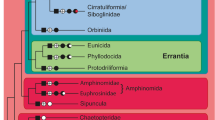Summary
The lenticulus ofHydrozetes lemnae represents an eye composed of a single cuticular cornea underlain by flat extensions of epidermal cells, two pigment cells, and a pair of lamellated bodies. The latter consist of about 100 vertically arranged lamellae which are orientated longitudinally in the animal. The lamellated bodies are accompanied by glia cells. Two large fat body cells separate the paired components medially. Each lamellated body is connected to a perikaryon located in the brain. It is evident that these components are parts of photoneurons of the central nervous system. Their vertically directed extensions are dendritic branches, terminating under the cornea as lamellated bodies. It is assumed that these are the photosensitive parts of the two photoneurons which serve as receptor cells. The axon of each cell runs transversely through the brain and terminates in a small distinct optic neuropile close to the opposite perikaryon. Thus the resulting chiasma opticum comprises two axons only. The extraordinary composition of this eye corroborates the assumption that it is a secondary light sense organ.
Similar content being viewed by others
References
Alberti G (1975) Prälarven und Phylogenie der Schnabelmilben (Bdellidae, Trombidiformes). Z Zool Syst Evolutionsforsch 13: 44–62
—,Storch V, Renner H (1981) Über den feinstrukturellen Aufbau der Milbencuticula (Acari, Arachnida). Zool Jb Anat 105: 183–236
Autrum H (1979) Introduction. In:Autrum H, Jung R, Lowenstein WR, McKay DM, Teuber LH (eds) Handbook of sensory physiology, vol VII/6 A. Springer, Berlin Heidelberg New York, pp 1–22
Balashov YS (ed) (1983) An atlas of ixodid tick ultrastructure. Spec Publ Entomol Soc Am, pp 289
Blest AD (1985) The fine structure of spider photoreceptors in relation to function. In:Barth FG (ed) Neurobiology ofArachnids. Springer, Berlin Heidelberg New York Tokyo, pp 79–102
Bloom W, Fawcett DW (1975) A textbook of histology, 10th edn. WB Saunders, Philadelphia, pp 1033
Duelli P (1978) An insect retina without microvilli in the male scale insect,Eriococcus sp. (Eriococcidae, Homoptera). Cell Tissue Res 187: 417–427
Eakin RM (1972) Structure of invertebrate photoreceptors. In:Autrum H, Jung R, Lowenstein WR, McKay DM, Teuber LH (eds) Handbook of sensory physiology, vol VII/1. Springer, Berlin Heidelberg New York, pp 624–684
—,Westfall JA (1965) Ultrastructure of the eye of the rotiferAsplanchna brightwelli. J Ultrastruct Res 12: 46–62
Fernandez NA, Athias-Binche F (1986) Analyse démographique d'une population d'Hydrozetes lemnae Coggi, Acarien Oribate inféodé à la lentille d'eau Lemna gibba L. en Argentine. I. Méthodes et techniques démographie d'H. lemnae comparisons avec d'autres Oribates. Zool Jb Syst 113: 213–228
Fahrenbach WH (1970) The morphology of theLimulus visual system III. The lateral rudimentary eye. Z Zellforsch 105: 303–316
— (1975) The visual system of the horseshoe crabLimulus polyphemus. Int Rev Cytol 41: 285–349
Grandjean F (1928) Sur un oribatide pourvu d'yeux. Bull Soc Zool France 53: 235–242
— (1958) Au sujet du naso et de son oeil infère chez les oribates et les Endeostigmata (Acariens). Bull Mus 2e Sér 30: 427–435
— (1961) Nouvelles observations sur les oribates (Ire Sér.). Acarologia 3: 206–231
— (1969) Stases. Actinopiline. Rappel de ma classification des Acariens en 3 groupes majeurs. Terminologie en soma. Acarologia 11: 796–827
Kaestner A (1965) Lehrbuch der Speziellen Zoologie, vol I, Wirbellose, part 1, 2nd edn. G Fischer Verlag, Stuttgart, pp 845
Menzel R, Snyder AW (1975) Introduction to photoreceptor optics-an overview. In:Snyder AW, Menzel R (eds) Photoreceptor optics. Springer, Berlin Heidelberg New York, pp 1–13
Mills LR (1974) Structure of the visual system of the two-spotted spider mite,Tetranychus urticae. J Insect Physiol 20: 795–808
Mischke U (1981) Die Ultrastruktur der Lateralaugen und des Medianauges der SüßwassermilbeHydryphantes ruber (Acarina: Parasitengona). Entomol Gen 7: 141–156
Oudemans AC (1913) Acarologisches aus Maulwurfsnestern. Arch Naturgesch A 10: 1–69, plate II–XVIII
— (1916) Notizen überAcari, 25. Reihe (Trombidiidae, Oribatidae, Phthiracaridae). Arch Naturgesch A 6: 1–84
Paulus HF (1979) Eye structure and the monophyly of theArthropoda. In:Gupta AP (ed) Arthropod phylogeny. Van Nostrand Reinhold, New York, pp 299–383
Phillis WA, Cromroy HL (1977) The microanatomy of the eye ofAmblyomma americanum (Acari: Ixodidae) and resultant implications of its structure. J Med Entomol 13: 685–698
Piersig R (1895) Beiträge zur Systematik und Entwicklungsgeschichte der Süßwassermilben. Zool Anz 18: 19–25
Richardson KC, Jarett L, Finke EH (1960) Embedding in epoxy resins for ultrathin sectioning in electron microscopy. Stain Technol 35: 313–323
Schuster R (1979) Soil mites in the marine environment. In:Rodriguez JG (ed) Recent advances in Acarology, vol 1. Academic Press, New York, pp 593–602
Tarman K (1961) Über Trichobothrien und Augen beiOribatei. Zool Anz 167: 51–58
Vitzthum C von (1935) 9. Ordnung derArachnida: Acari=Milben. In:Kükenthal W, Krumbach Th (eds) Handbuch der Zoologie, vol 3/2, part 3. De Gruyter, Berlin, pp 1–160
— (1943)Acarina. In:Bronns Klassen und Ordnungen des Tierreichs, vol 5, IV, 5. Akad Verlagsges, Leipzig, pp 1011
Wachmann E (1975) Feinstruktur der Lateralaugen einer räuberischen Milbe (Microcaeculus) (Acari: Prostigmata: Caeculidae). Entomol Germ 1: 300–307
—,Haupt J, Richter S, Coineau Y (1974) Die Medianaugen vonMicrocaeculus (Acari, Prostigmata, Caeculidae). Z Morphol Tiere 79: 199–213
Yoshida M (1979) Extraocular photoreception. In:Autrum H, Jung R, Lowenstein WR, McKay DM, Teuber LH (eds) Handbook of sensory physiology, vol VII/6 A. Springer, Berlin Heidelberg New York, pp 581–640
Author information
Authors and Affiliations
Rights and permissions
About this article
Cite this article
Alberti, G., Fernandez, N.A. Fine structure of a secondarily developed eye in the freshwater moss-mite,Hydrozetes lemnae (Coggi, 1899) (Acari: Oribatida). Protoplasma 146, 106–117 (1988). https://doi.org/10.1007/BF01405919
Received:
Accepted:
Issue Date:
DOI: https://doi.org/10.1007/BF01405919




